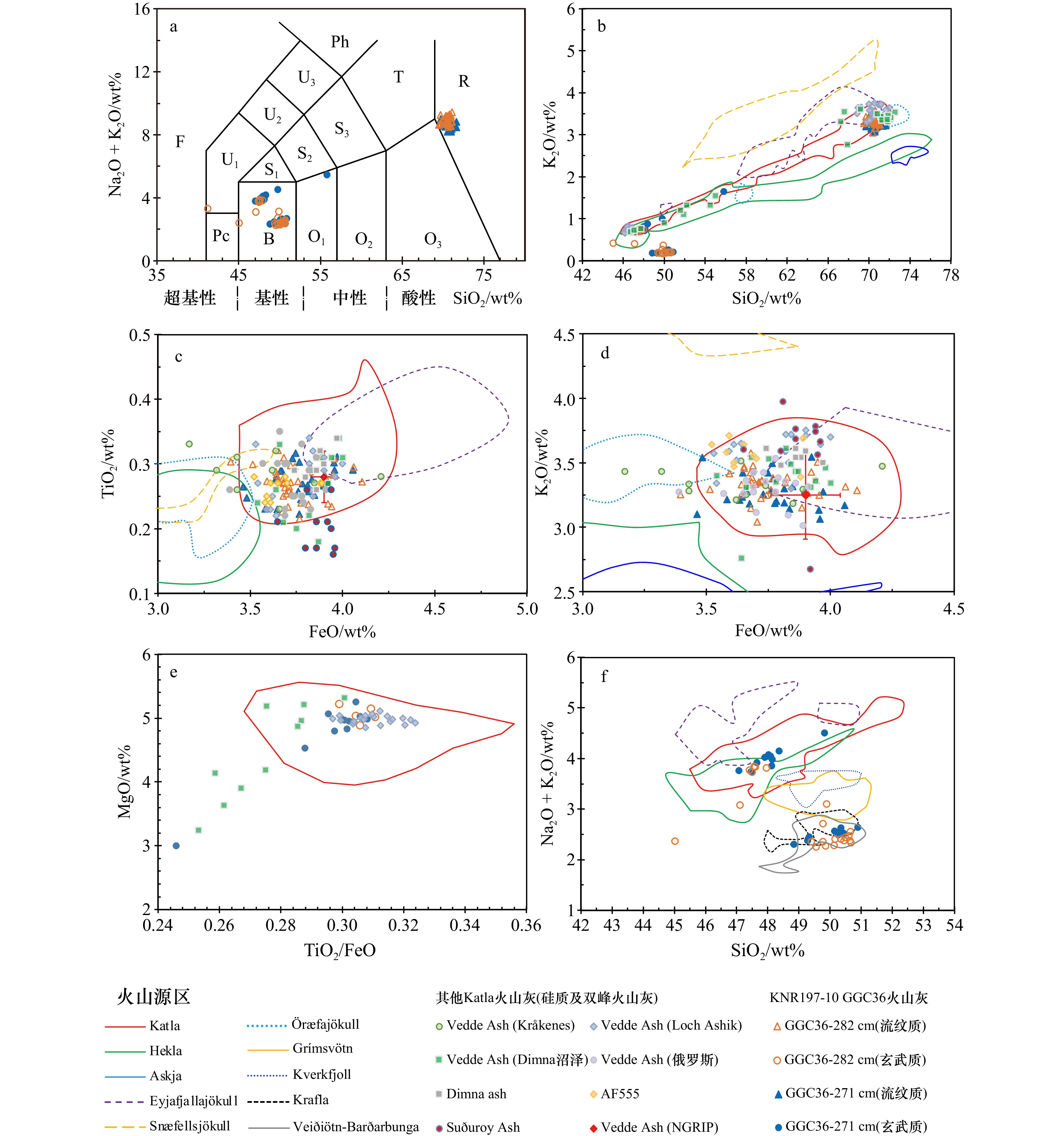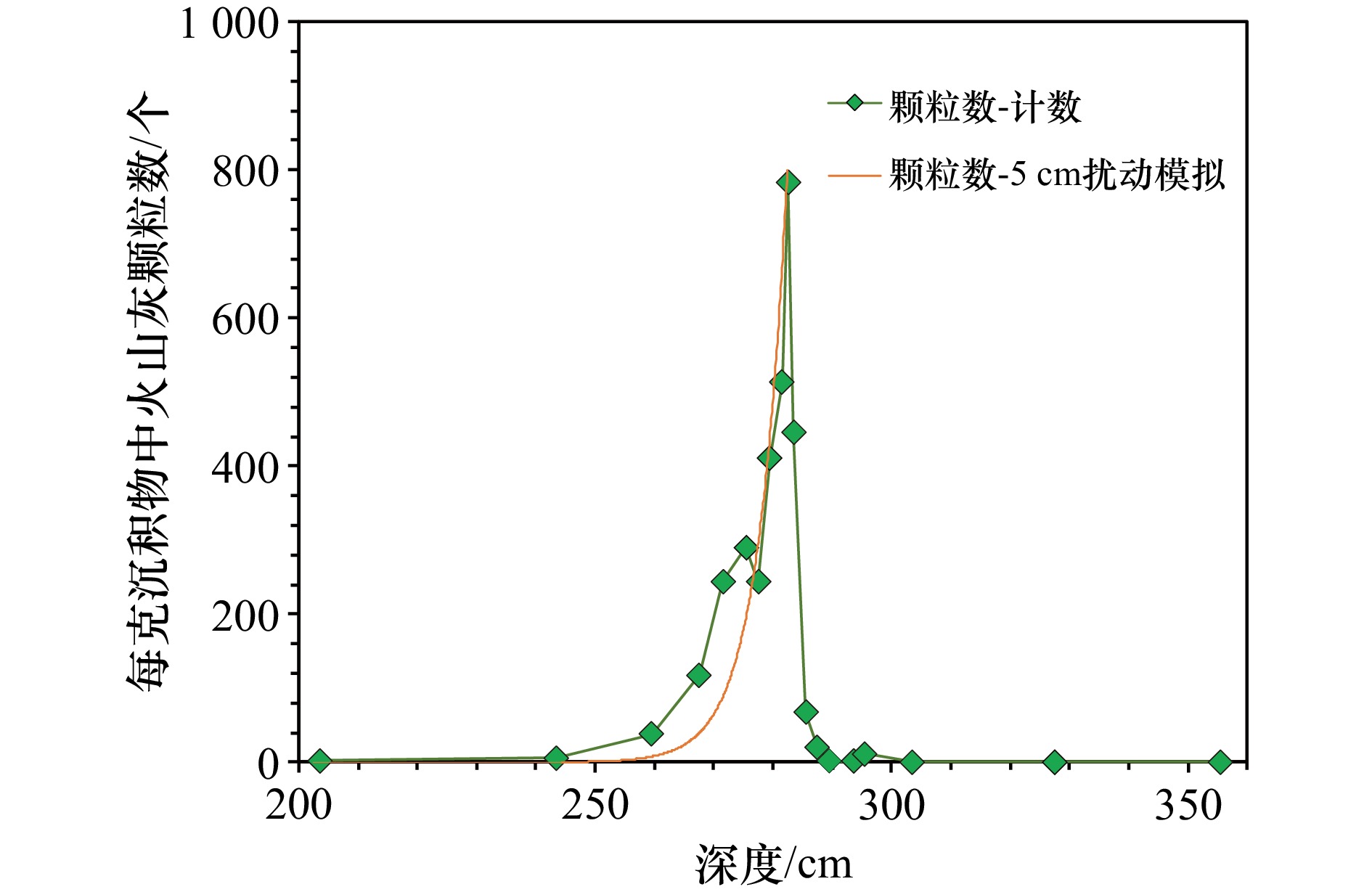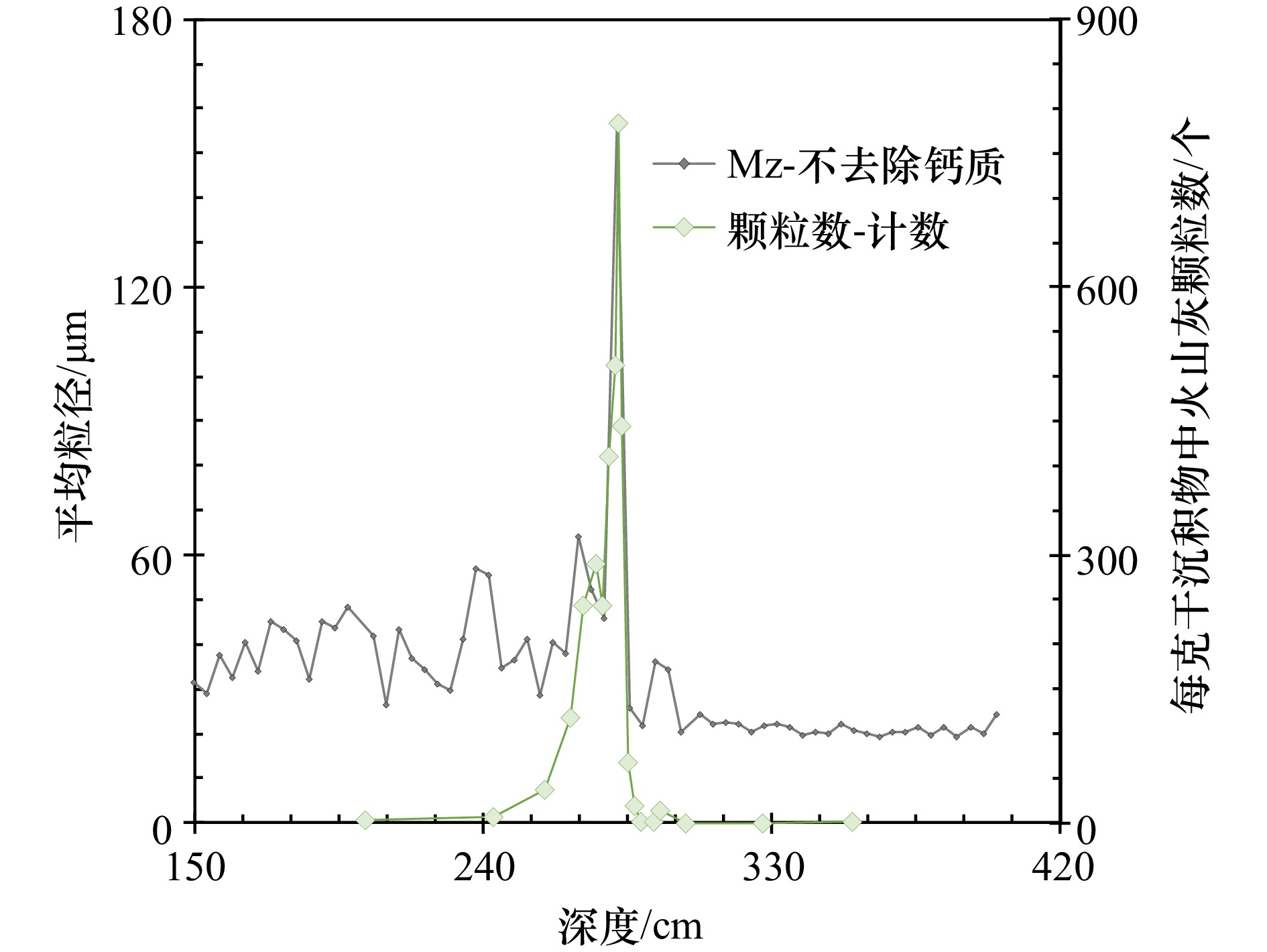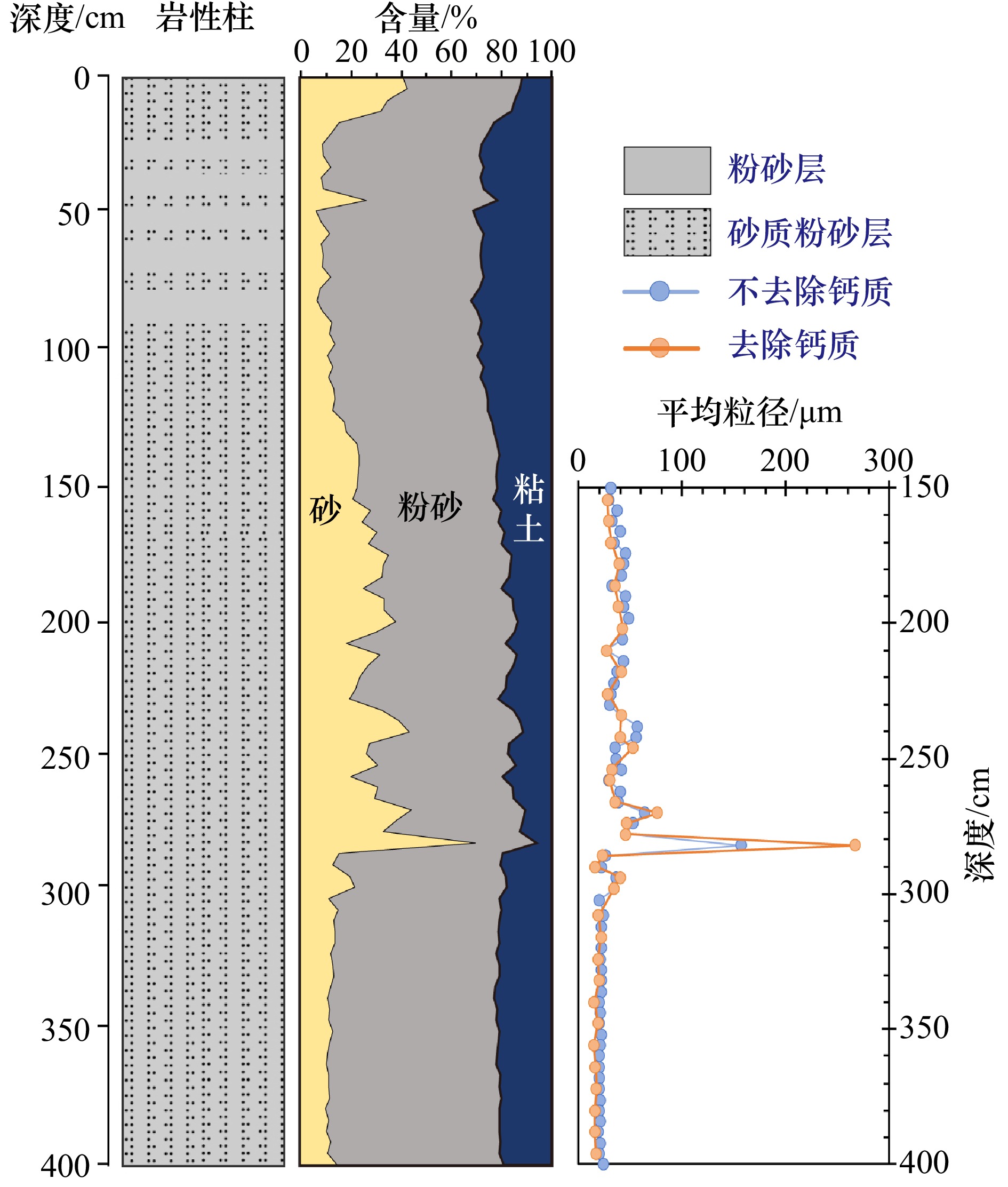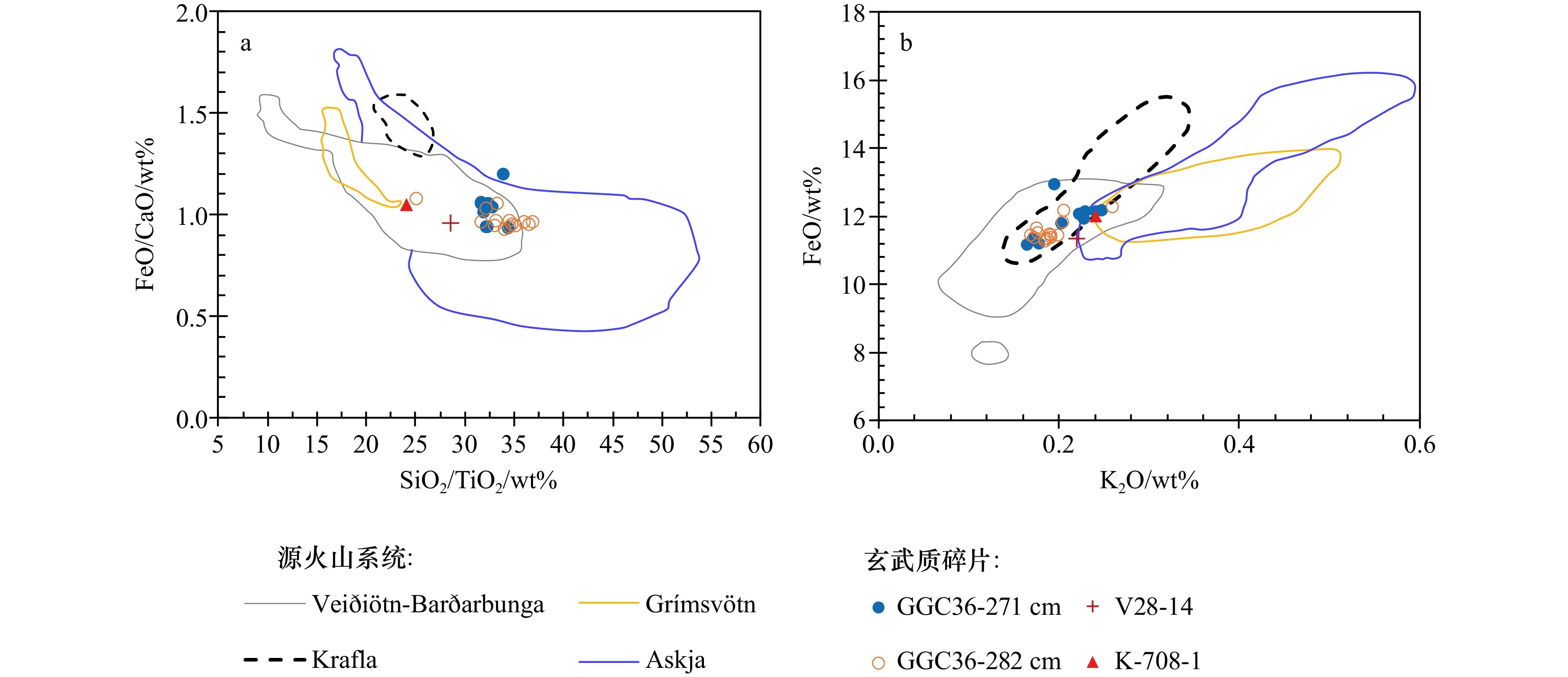Vedde Ash-based marine reservoir age reconstruction of the mid-latitude Northwest Atlantic
-
摘要: 海表碳库年龄对于海洋放射性碳年代校准和海洋环流重建等具有重要价值。爆炸性火山喷发产生的火山灰地层时标,能够建立海洋和陆地放射性碳定年样本的联系,帮助重建过去的海表碳库年龄。然而,冰筏漂流、生物扰动等因素增加了火山灰时标的复杂性,尤其是距离火山源较远位置的研究区域。本研究以中纬度北大西洋的一根高沉积速率岩心为例,分析了柱样中的火山灰丰度与地球化学成分,揭示了其与高纬北大西洋火山灰层I的对应关系。结合放射性碳定年以及北大西洋相关沉积岩心证据,我们系统评估了中高纬北大西洋Vedde火山灰等时线的可靠性,并推断出Vedde火山灰经由海冰向西北大西洋输运的传输模式。本研究的高分辨率火山灰丰度层序印证了生物扰动对远距离传输沉降的薄层火山灰在地层中分布的影响,进一步强调了海洋沉积记录中生物扰动校正的重要性。经生物扰动校正后,岩心区域新仙女木时期的海表碳库年龄估值为799±58年,与同时期亚极地北大西洋的海表碳库年龄呈现较好的一致性。我们的研究表明,在对火山灰时标的可靠性进行评估后,Vedde等源自高纬北大西洋的火山灰可在更大空间范围内得到应用。Abstract: Marine reservoirs ages are of great value for the calibration of marine radiocarbon dates and the reconstruction of ocean circulation. Tephras from explosive volcanic eruptions can link marine and terrestrial radiocarbon-dated samples, aiding in the reconstruction of past marine reservoir ages. However, factors such as bioturbation and ice-rafted debris increase the complexity of the tephra chronostratigraphy, especially in study areas located far from the source volcano. This study analyzes the abundance and geochemical composition of tephras in a high-deposition-rate core from the mid-latitude North Atlantic, demonstrating its correlation with North Atlantic Ash Zone I from higher latitudes. By combining radiocarbon dating results with evidence from other sediment cores in the North Atlantic, we systematically evaluated the reliability of the Vedde Ash isochron in the mid- to high-latitude North Atlantic and inferred a transport mechanism for the Vedde Ash via sea ice to the Northwest Atlantic. Our high-resolution tephra abundance stratigraphy confirms the effect of bioturbation on the distribution of thin tephra layers in sediment cores, further emphasizing the importance of bioturbation correction in marine sediment records. After bioturbation correction, the marine reservoir age estimated for the core region during the Younger Dryas is 758±58 14C yr, which is in good agreement with the marine reservoir age distribution in the subpolar North Atlantic during the same period. Our study shows that, after evaluating the reliability of the tephra chronostratigraphy, Vedde and other tephras from the high-latitude North Atlantic can be applied over a wider spatial range.
-
Key words:
- marine reservoir age /
- tephra chronostratigraphy /
- North Atlantic /
- the Younger Dryas
-
图 2 本研究中沉积岩心与集成记录分布图。(a)本文所提及的相关岩心[1, 25, 30–33]、冰芯[22, 34, 35]及陆地沉积物[20, 21, 23, 36, 37]火山灰层位置。岩心KNR197-10 GGC36使用黄色突出显示,集成记录岩芯[16–19, 24, 25, 32, 38–42]用紫色显示。(b)西北大西洋海表环流示意图(寒流用蓝色标示,暖流用红色标示)。
Fig. 2 Map of the sediment cores and compiled records in this study. (a)The locations of the marine sediment cores[1, 25, 30–33], ice cores[22, 34, 35] and terrestrial sediment records with tephra layers relevant to this study, with GGC36 highlighted in yellow, and the compiled records[16–19, 24, 25, 32, 38–42] highlighted in purple. (b) Schematic representation of the modern North Atlantic surface circulation (blue: cold current, red: warm current).
图 3 岩心GGC36火山灰玻璃成分的TAS图及源区鉴别双元素图解。(a)TAS图解[55],(b)GGC36火山灰与挪威Dimna 沼泽[23]及苏格兰Loch Ashik湖[53]双峰Vedde Ash对比,(c/d)GGC36流纹质火山灰与欧洲[4, 20, 21, 23, 53, 54]及格陵兰岛[22]Katla流纹质火山灰组分对比,(e/f)GGC36玄武质火山灰的地球化学图解。NGRIP的火山灰层显示为均值与标准差[22]。
Fig. 3 The total alkali-silica (TAS) diagram and the source discrimination biplots of tephra in core GGC36. (a) Total alkali versus silica (TAS) diagram[55], (b) tephra at two depths of core GGC36 compared with the bimodal Vedde Ash in Dimna Bog, Norway[23] and Loch Ashik, Scotland[53], (c/d) rhyolitic tephra in core GGC36 compared with similar Katla tephra layers in Europe [4, 20, 21, 23, 53, 54] and Greenland[22], (e/f) the geochemical diagram of basaltic tephra in GC36. NGRIP data are plotted as average values and standard deviations [22].
图 8 岩心GGC36中VBVS源火山灰与北大西洋沉积岩心V 28-14、K-708-1中NAAZ I拉斑玄武质火山灰[1]的对比
Fig. 8 Comparison of tephras sourced from VBVS in core GGC36 with tholeiitic tephra in NAAZ1 of cores V28-14 & K-708-1.
表 1 Vedde火山灰的14C年代
Tab. 1 14C age of the Vedde Ash
站点位置 定年样品类型 样品相对于火山灰层的位置 常规14C年代
(a BP)火山灰14C年龄
均值(a BP)参考文献 Kråkenes湖 陆生植物宏观化石 上覆 10 230±90 10 301±37 Birks等[4];Lohne等[56] Kråkenes湖 陆生植物宏观化石 包含 10 300±110 Birks等[4];Lohne等[56] Kråkenes湖 陆生植物宏观化石 包含 10 305±95 Birks等[4];Lohne等[56] Kråkenes湖 陆生植物宏观化石 下伏 10 415±95 Birks等[4];Lohne等[56] Heggjadalsetra古湖 苔藓 包含 10 325±115 Bard等[17] Heggjadalsetra古湖 苔藓 包含 10 360±80 Bard等[17] Torvlømyra湖 陆生植物碎片 包含 10 430±240 Bard等[17] Torvlømyra湖 陆生植物碎片 包含 10 040±260 Bard等[17] Torvlømyra湖 陆生植物碎片 包含 9 950±160 Bard等[17] 表 2 KNR197-10 GGC36的浮游有孔虫14C定年结果
Tab. 2 14C dates of planktonic foraminifera in KNR197-10 GGC36
深度
(cm)浮游有孔虫属种 AMS 14C年代
(a BP)误差(σ)
(a BP)校正的日历年龄范围#
(cal a BP)255−256 N. pachyderma 10 900 35 11 460−11 962(95.4%) 277−278 N. pachyderma 11 100 45 11 946−12 603(95.4%) 282−283 G. bulloides 11 180 40 — 282−283 N. pachyderma 11 530 40 12 028−12 764(95.4%) # 基于IntCal20曲线和贝叶斯年龄建模(Bacon)[41]方法,使用本研究估算的海表碳库年龄799±58年校正 表 3 岩心MD99-
2275 的部分火山灰地层信息(引自Gudmunsdóttir等[63])Tab. 3 Tephra stratigraphic data from core MD99-
2275 (partial)火山灰层
深度(cm)原火山系统 年代
(cal a BP)参考文献 3 372−3 373 VBVS 12 045 Søndergaard[64] ; Gudmunsdóttir等[63] ~3 390−3 407 Katla (VA) 12 120 Eiríksson等[65] ; Gudmunsdóttir等[63] 3 412−3 413 VBVS 12 165 Søndergaard[64] ; Gudmunsdóttir等[63] 3 417−3 418 KVS 12 210 Søndergaard[64] ; Gudmunsdóttir等[63] 3 468−3 469 GVS 12 667 Søndergaard[64] ; Gudmunsdóttir等[63] -
[1] Mangerud J, Lie S E, Furnes H, et al. A Younger Dryas Ash Bed in western Norway, and its possible correlations with tephra in cores from the Norwegian Sea and the North Atlantic[J]. Quaternary Research, 1984, 21(1): 85−104. doi: 10.1016/0033-5894(84)90092-9 [2] Lane C S, Blockley S P E, Mangerud J, et al. Was the 12.1 ka Icelandic Vedde Ash one of a kind?[J]. Quaternary Science Reviews, 2012, 33: 87−99. doi: 10.1016/j.quascirev.2011.11.011 [3] Lowe D J. Tephrochronology and its application: a review[J]. Quaternary Geochronology, 2011, 6(2): 107−153. doi: 10.1016/j.quageo.2010.08.003 [4] Birks H H, Gulliksen S, Haflidason H, et al. New radiocarbon dates for the Vedde Ash and the Saksunarvatn Ash from western Norway[J]. Quaternary Research, 1996, 45(2): 119−127. doi: 10.1006/qres.1996.0014 [5] Rasmussen S O, Andersen K K, Svensson A M, et al. A new Greenland ice core chronology for the last glacial termination[J]. Journal of Geophysical Research: Atmospheres, 2006, 111(D6): D06102. [6] Heaton T J, Bard E, Bronk Ramsey C, et al. Radiocarbon: a key tracer for studying Earth’s dynamo, climate system, carbon cycle, and Sun[J]. Science, 2021, 374(6568): abd7096. doi: 10.1126/science.abd7096 [7] Audi G, Bersillon O, Blachot J, et al. The Nubase evaluation of nuclear and decay properties[J]. Nuclear Physics A, 2003, 729(1): 3−128. doi: 10.1016/j.nuclphysa.2003.11.001 [8] Hughes E E, Mann W B. The half-life of carbon-14: comments on the mass-spectrometric method[J]. The International Journal of Applied Radiation and Isotopes, 1964, 15(3): 97−100. doi: 10.1016/0020-708X(64)90038-9 [9] Mangerud J. Radiocarbon dating of marine shells, including a discussion of apparent age of recent shells from Norway[J]. Boreas, 1972, 1(2): 143−172. doi: 10.1111/j.1502-3885.1972.tb00147.x [10] Alves E Q, Macario K, Ascough P, et al. The worldwide marine radiocarbon reservoir effect: definitions, mechanisms, and prospects[J]. Reviews of Geophysics, 2018, 56(1): 278−305. doi: 10.1002/2017RG000588 [11] Siani G, Paterne M, Michel E, et al. Mediterranean sea surface radiocarbon reservoir age changes since the last glacial maximum[J]. Science, 2001, 294(5548): 1917−1920. doi: 10.1126/science.1063649 [12] Hua Quan, Webb G E, Zhao Jianxin, et al. Large variations in the Holocene marine radiocarbon reservoir effect reflect ocean circulation and climatic changes[J]. Earth and Planetary Science Letters, 2015, 422: 33−44. doi: 10.1016/j.jpgl.2015.03.049 [13] Sikes E L, Guilderson T P. Southwest Pacific Ocean surface reservoir ages since the last glaciation: circulation insights from multiple‐core studies[J]. Paleoceanography, 2016, 31(2): 298−310. doi: 10.1002/2015PA002855 [14] Skinner L C, Bard E. Radiocarbon as a dating tool and tracer in paleoceanography[J]. Reviews of Geophysics, 2022, 60(1): e2020RG000720. doi: 10.1029/2020RG000720 [15] Siani G, Michel E, De Pol-Holz R, et al. Carbon isotope records reveal precise timing of enhanced Southern Ocean upwelling during the last deglaciation[J]. Nature Communications, 2013, 4(1): 2758. doi: 10.1038/ncomms3758 [16] Austin W E N, Bard E, Hunt J B, et al. The 14C age of the icelandic vedde ash: implications for younger dryas marine reservoir age corrections[J]. Radiocarbon, 1995, 37(1): 53−62. doi: 10.1017/S0033822200014788 [17] Bard E, Arnold M, Mangerud J, et al. The North Atlantic atmosphere-sea surface 14C gradient during the Younger Dryas climatic event[J]. Earth and Planetary Science Letters, 1994, 126(4): 275−287. doi: 10.1016/0012-821X(94)90112-0 [18] Muschitiello F, D’Andrea W J, Schmittner A, et al. Deep-water circulation changes lead North Atlantic climate during deglaciation[J]. Nature Communications, 2019, 10(1): 1272. doi: 10.1038/s41467-019-09237-3 [19] Bondevik S, Mangerud J, Gulliksen S. The marine 14C age of the Vedde Ash Bed along the west coast of Norway[J]. Journal of Quaternary Science, 2001, 16(1): 3−7. doi: 10.1002/1099-1417(200101)16:1<3::AID-JQS592>3.0.CO;2-G [20] Wastegård S. Early to middle Holocene silicic tephra horizons from the Katla volcanic system, Iceland: new results from the Faroe Islands[J]. Journal of Quaternary Science, 2002, 17(8): 723−730. doi: 10.1002/jqs.724 [21] Matthews I P, Birks H H, Bourne A J, et al. New age estimates and climatostratigraphic correlations for the Borrobol and Penifiler Tephras: evidence from Abernethy Forest, Scotland[J]. Journal of Quaternary Science, 2011, 26(3): 247−252. doi: 10.1002/jqs.1498 [22] Mortensen A K, Bigler M, Grönvold K, et al. Volcanic ash layers from the Last Glacial Termination in the NGRIP ice core[J]. Journal of Quaternary Science, 2005, 20(3): 209−219. doi: 10.1002/jqs.908 [23] Koren J H, Svendsen J I, Mangerud J, et al. The Dimna Ash—a 12.814Cka-old volcanic ash in western Norway[J]. Quaternary Science Reviews, 2008, 27(1/2): 85−94. [24] Bond G C, Mandeville C, Hoffmann S. Were rhyolitic glasses in the Vedde Ash and in the North Atlantic's Ash Zone 1 produced by the same volcanic eruption?[J]. Quaternary Science Reviews, 2001, 20(11): 1189−1199. doi: 10.1016/S0277-3791(00)00146-3 [25] Thornalley D J R, McCave I N, Elderfield H. Tephra in deglacial ocean sediments south of Iceland: Stratigraphy, geochemistry and oceanic reservoir ages[J]. Journal of Quaternary Science, 2011, 26(2): 190−198. doi: 10.1002/jqs.1442 [26] Griggs A J, Davies S M, Abbott P M, et al. Optimising the use of marine tephrochronology in the North Atlantic: a detailed investigation of the Faroe Marine Ash Zones II, III and IV[J]. Quaternary Science Reviews, 2014, 106: 122−139. doi: 10.1016/j.quascirev.2014.04.031 [27] Schindlbeck J C, Kutterolf S, Freundt A, et al. Emplacement processes of submarine volcaniclastic deposits(IODP Site C0011, Nankai Trough)[J]. Marine Geology, 2013, 343: 115−124. doi: 10.1016/j.margeo.2013.06.017 [28] Bard E, Arnold M, Duprat J, et al. Reconstruction of the last deglaciation: deconvolved records of δ18O profiles, micropaleontological variations and accelerator mass spectrometric 14C dating[J]. Climate Dynamics, 1987, 1(2): 101−112. doi: 10.1007/BF01054479 [29] Bard E. Correction of accelerator mass spectrometry 14C ages measured in planktonic foraminifera: paleoceanographic implications[J]. Paleoceanography, 1988, 3(6): 635−645. doi: 10.1029/PA003i006p00635 [30] Hunt J B, Fannin N G T, Hill P G, et al. The tephrochronology and radiocarbon dating of North Atlantic, Late-Quaternary sediments: an example from the St. Kilda Basin[J]. Geological Society, 1995, 90(1): 227−248. doi: 10.1144/GSL.SP.1995.090.01.15 [31] Kvamme T, Mangerud J, Furnes H, et al. Geochemistry of Pleistocene ash zones in cores from the North Atlantic[J]. Norsk Geologisk Tidsskrift, 1989, 69: 251−272. [32] You Defang, Stein R, Fahl K, et al. Last deglacial abrupt climate changes caused by meltwater pulses in the Labrador Sea[J]. Communications Earth & Environment, 2023, 4(1): 81. [33] Voelker A H L, Haflidason H. Refining the Icelandic tephrachronology of the last glacial period–the deep-sea core PS2644 record from the southern Greenland Sea[J]. Global and Planetary Change, 2015, 131: 35−62. doi: 10.1016/j.gloplacha.2015.05.001 [34] Cook E, Abbott P M, Pearce N J G, et al. Volcanism and the Greenland ice cores: a new tephrochronological framework for the last glacial-interglacial transition(LGIT) based on cryptotephra deposits in three ice cores[J]. Quaternary Science Reviews, 2022, 292: 107596. doi: 10.1016/j.quascirev.2022.107596 [35] Grönvold K, Óskarsson N, Johnsen S J, et al. Ash layers from Iceland in the Greenland GRIP ice core correlated with oceanic and land sediments[J]. Earth and Planetary Science Letters, 1995, 135(1/4): 149−155. [36] Björck S, Ingólfsson Ó, Haflidason H, et al. Lake Torfadalsvatn: a high resolution record of the North Atlantic ash zone I and the last glacial-interglacial environmental changes in Iceland[J]. Boreas, 1992, 21(1): 15−22. doi: 10.1111/j.1502-3885.1992.tb00009.x [37] Harning D J, Thordarson T, Geirsdóttir Á, et al. Repeated Early Holocene eruptions of Katla, Iceland, limit the temporal resolution of the Vedde Ash[J]. Bulletin of Volcanology, 2024, 86(1): 2. [38] Risebrobakken B, Jansen E, Andersson C, et al. A high-resolution study of Holocene paleoclimatic and paleoceanographic changes in the Nordic Seas[J]. Paleoceanography, 2003, 18(1): 1017. [39] Austin W E N, Telford R J, Ninnemann U S, et al. North Atlantic reservoir ages linked to high Younger Dryas atmospheric radiocarbon concentrations[J]. Global and Planetary Change, 2011, 79(3/4): 226−233. [40] Karpuz N K, Jansen E. A high-resolution diatom record of the last deglaciation from the SE Norwegian Sea: documentation of rapid climatic changes[J]. Paleoceanography, 1992, 7(4): 499−520. doi: 10.1029/92PA01651 [41] Eiríksson J, Knudsen K L, Haflidason H, et al. Late-glacial and Holocene palaeoceanography of the North Icelandic shelf[J]. Journal of Quaternary Science, 2000, 15(1): 23−42. doi: 10.1002/(SICI)1099-1417(200001)15:1<23::AID-JQS476>3.0.CO;2-8 [42] Schoning K. Palaeohydrography and marine conditions in the south-western part of the Vänern basin during the Younger Dryas and Early Preboreal[J]. GFF, 2002, 124(1): 1−10. doi: 10.1080/11035890201241001 [43] Jagan A. Tephra stratigraphy and geochemistry from three Icelandic lake cores: a new method for determining source volcano of tepra layers[D]. Edinburgh: The University of Edinburgh, 2010. [44] Óladóttir B A, Sigmarsson O, Larsen G, et al. Provenance of basaltic tephra from Vatnajökull subglacial volcanoes, Iceland, as determined by major- and trace-element analyses[J]. The Holocene, 2011, 21(7): 1037−1048. doi: 10.1177/0959683611400456 [45] Haflidason H, Eiriksson J, Van Kreveld S. The tephrochronology of Iceland and the North Atlantic region during the Middle and Late Quaternary: a review[J]. Journal of Quaternary Science, 2000, 15(1): 3−22. doi: 10.1002/(SICI)1099-1417(200001)15:1<3::AID-JQS530>3.0.CO;2-W [46] Ramsey C B, Housley R A, Lane C S, et al. The RESET tephra database and associated analytical tools[J]. Quaternary Science Reviews, 2015, 118: 33−47. doi: 10.1016/j.quascirev.2014.11.008 [47] Stuiver M, Pearson G W, Braziunas T. Radiocarbon age calibration of marine samples back to 9000 cal yr BP[J]. Radiocarbon, 1986, 28(2B): 980−1021. doi: 10.1017/S0033822200060264 [48] Bevington P R, Robinson D K, Blair J M, et al. Data reduction and error analysis for the physical sciences[J]. Computers in Physics, 1993, 7(4): 415−416. doi: 10.1063/1.4823194 [49] Blaauw M, Christen J A. Flexible paleoclimate age-depth models using an autoregressive gamma process[J]. Bayesian Analysis, 2011, 6(3): 457−474. doi: 10.1214/ba/1339616472 [50] Carstens J, Hebbeln D, Wefer G. Distribution of planktic foraminifera at the ice margin in the Arctic(Fram Strait)[J]. Marine Micropaleontology, 1997, 29(3/4): 257−269. [51] Simstich J, Sarnthein M, Erlenkeuser H. Paired δ18O signals of Neogloboquadrina pachyderma(s) and Turborotalita quinqueloba show thermal stratification structure in Nordic Seas[J]. Marine Micropaleontology, 2003, 48(1/2): 107−125. [52] Key R M, Kozyr A, Sabine C L, et al. A global ocean carbon climatology: results from Global Data Analysis Project(GLODAP)[J]. Global Biogeochemical Cycles, 2004, 18(4): GB4031. [53] Davies S M, Turney C S M, Lowe J J. Identification and significance of a visible, basalt-rich Vedde Ash layer in a Late-glacial sequence on the Isle of Skye, Inner Hebrides, Scotland[J]. Journal of Quaternary Science, 2001, 16(2): 99−104. doi: 10.1002/jqs.611 [54] Wastegård S, Wohlfarth B, Subetto D A, et al. Extending the known distribution of the Younger Dryas Vedde Ash into northwestern Russia[J]. Journal of Quaternary Science, 2000, 15(6): 581−586. doi: 10.1002/1099-1417(200009)15:6<581::AID-JQS558>3.0.CO;2-3 [55] Le Bas M J, Le Maitre R W, Streckeisen A, et al. A chemical classification of volcanic rocks based on the total alkali-silica diagram[J]. Journal of Petrology, 1986, 27(3): 745−750. doi: 10.1093/petrology/27.3.745 [56] Lohne Ø S, Mangerud J, Birks H H. Precise 14C ages of the Vedde and Saksunarvatn ashes and the Younger Dryas boundaries from western Norway and their comparison with the Greenland Ice Core (GICC05) chronology[J]. Journal of Quaternary Science, 2013, 28(5): 490−500. doi: 10.1002/jqs.2640 [57] Zhao Ning. Reconstructing deglacial ocean ventilation using radiocarbon: data and inverse modeling[D]. Woods Hole: Woods Hole Oceanographic Institution, 2017. [58] Rutledal S. Tephrochronology of the North Atlantic during the Last Glacial period–a paleoclimate synchronization tool[D]. Bergen: University of Bergen, 2021. [59] Duggen S, Olgun N, Croot P, et al. The role of airborne volcanic ash for the surface ocean biogeochemical iron-cycle: a review[J]. Biogeosciences, 2010, 7(3): 827−844. doi: 10.5194/bg-7-827-2010 [60] Bäckström D L, Kuijpers A, Heinemeier J. Late Quaternary North Atlantic paleoceanographic records and stable isotopic bariability four planktonic foraminiferal species[J]. Journal of Foraminiferal Research, 2001, 31(1): 25−32. doi: 10.2113/0310025 [61] Ruddiman W F, Glover L K. Vertical mixing of ice-rafted volcanic ash in North Atlantic Sediments[J]. Geological Society of America Bulletin, 1972, 83(9): 2817−2836. doi: 10.1130/0016-7606(1972)83[2817:VMOIVA]2.0.CO;2 [62] Thordarson T, Larsen G. Volcanism in Iceland in historical time: volcano types, eruption styles and eruptive history[J]. Journal of Geodynamics, 2007, 43(1): 118−152. doi: 10.1016/j.jog.2006.09.005 [63] Gudmundsdóttir E R, Larsen G, Eiríksson J. Tephra stratigraphy on the North Icelandic shelf: extending tephrochronology into marine sediments off North Iceland[J]. Boreas, 2012, 41(4): 718−734. [64] Søndergaard M. Lateglacial and Holocene palaeoclimatic fluctuations on the North Icelandic shelf: foraminiferal analysis, sedimentology and tephrochronology of core MD992275[D]. Aarhus: University of Aarhus, 2005. [65] Eiríksson J, Larsen G, Knudsen K L, et al. Marine reservoir age variability and water mass distribution in the Iceland Sea[J]. Quaternary Science Reviews, 2004, 23(20/22): 2247−2268. [66] Lacasse C. Influence of climate variability on the atmospheric transport of Icelandic tephra in the subpolar North Atlantic[J]. Global and Planetary Change, 2001, 29(1/2): 31−55. [67] Davies S M, Larsen G, Wastegård S, et al. Widespread dispersal of Icelandic tephra: how does the Eyjafjöll eruption of 2010 compare to past Icelandic events?[J]. Journal of Quaternary Science, 2010, 25(5): 605−611. doi: 10.1002/jqs.1421 [68] Saxby J, Rust A, Cashman K, et al. The importance of grain size and shape in controlling the dispersion of the Vedde cryptotephra[J]. Journal of Quaternary Science, 2020, 35(1/2): 175−185. [69] Dolman A M, Groeneveld J, Mollenhauer G, et al. Estimating bioturbation from replicated small-sample radiocarbon ages[J]. Paleoceanography and Paleoclimatology, 2021, 36(7): 2020PA004142. doi: 10.1029/2020PA004142 [70] Galbraith E D, Kwon E Y, Bianchi D, et al. The impact of atmospheric pCO2 on carbon isotope ratios of the atmosphere and ocean[J]. Global Biogeochemical Cycles, 2015, 29(3): 307−324. doi: 10.1002/2014GB004929 [71] Alley R B, Clark P U. The deglaciation of the Northern Hemisphere: a global perspective[J]. Annual Review of Earth and Planetary Sciences, 1999, 27: 149−182. doi: 10.1146/annurev.earth.27.1.149 [72] Keigwin L D, Boyle E A. Did North Atlantic overturning halt 17, 000 years ago?[J]. Paleoceanography, 2008, 23(1): PA1101. [73] Sy A, Rhein M, Lazier J R N, et al. Surprisingly rapid spreading of newly formed intermediate waters across the North Atlantic Ocean[J]. Nature, 1997, 386(6626): 675−679. doi: 10.1038/386675a0 [74] Stocker T F, Schmittner A. Influence of CO2 emission rates on the stability of the thermohaline circulation[J]. Nature, 1997, 388(6645): 862−865. doi: 10.1038/42224 -





 下载:
下载:

